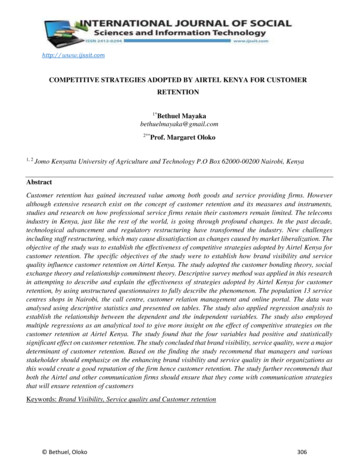
Transcription
How To CreateA Competitive Benchmark AnalysisOn Social MediaHOW TO CREATE A COMPETITVE BENCHMARK ANALYSIS ON SOCIAL MEDIAwww.digimind.com1
CONTENTSINTRODUCTION – WHY MEASURE?3GETTING STARTED – WHICH CHANNELS & METRICS?4CREATE A COMPETITIVE ANALYSIS5COMMUNITY SIZE & GROWTH8BASELINE YOUR OWN BENCHMARKS10COMPARE COMMUNITY SIZE & GROWTH WITH COMPETITORS13COMPARE INTERACTIONS & ENGAGEMENT RATES15COMPARE PUBLICATIONS & TOP CONTENT19SUMMARY OF METRICS22ANALYSIS & REPORTING23CONCLUSION24MORE DIGIMIND EBOOKS25CONTRIBUTOR27ABOUT28DIGIMIND SOCIAL MEASURES THE GLOBAL E-REPUTATIONFOR BRANDS29
INTRODUCTIONCompetitive analysis on social media canprovide valuable insights for marketers.It allows brands to understand how theystack up in the market, keep an eye oncompetitors’ campaign performance, andidentify opportunities to optimize their owncontent strategies. By being armed withthis knowledge, social marketers are able tomake more informed, strategic decisions andwithout too much heavy lifting.This guide aims to provide you with bestpractices for understanding what yourcompetitors are doing on social media, howeffective their strategies are, and what youcan be doing better to stay one step ahead.HOW TO CREATE A COMPETITVE BENCHMARK ANALYSIS ON SOCIAL MEDIAwww.digimind.com3
GETTING STARTEDWhich Channels & Metrics?Before conducting a competitive analysis,it’s imperative to identify which metrics areimportant to your social media marketingstrategy and why. This starts with havinga clear vision of your marketing goals,and deciding how social media fits intoaccomplishing them.It’s also important to prioritize which socialchannels fit into your marketing needs.Facebook and Twitter are the obvious bigplayers, alongside Google . Many B2Ccompanies also leverage visually-basedsocial networks such as Instagram, Pinterest,Youtube, and Vine, while B2B brands may optto concentrate their efforts on LinkedIn.Whichever metrics and channels you prioritizewill play a key role in how you decide topublish, measure, and report. Once these areestablished, you will have a clear directionof the metrics and channels to benchmarkagainst your competitors.HOW TO CREATE A COMPETITVE BENCHMARK ANALYSIS ON SOCIAL MEDIAwww.digimind.com4
CREATE A COMPETITIVEANALYSISOnce you have set your goals for metrics &social channels, there are a couple ways tobegin conducting a competitive analysis.ManuallyIt is possible to aggregate metrics from eachsocial channel individually by visiting theirpages regularly and copying data into aspreadsheet. This could be somewhat tedious,but it is an option for brands on a limitedbudget.Social Analytics ToolUsing a social analytics tool is one of theeasiest ways to not only quickly create acompetitive analysis, but visualize the data in ameaningful way. While it often requires somemonetary investment, you can expect to savetime and gain actionable insights that you maynot find by manually monitoring pages.For this guide, we used Digimind SocialAnalytics, which allows brands to monitorhundreds of social accounts on Facebook,Twitter, Google , Instagram, LinkedIn, YouTube,& Pinterest.HOW TO CREATE A COMPETITVE BENCHMARK ANALYSIS ON SOCIAL MEDIAwww.digimind.com5
“Using a social analytics tool isone of the easiest ways to notonly quickly createa competitive analysis, butvisualize the data in ameaningful way.”Share this Ebook:
Let’s start with a few metrics that are oftencrucial when comparing your brand’s socialmedia presence with the competition. Community Size & GrowthVolume of interactions & engagementrate (Likes, shares, retweets, etc.)Volume & type of publications (Posts,tweets, etc.)HOW TO CREATE A COMPETITVE BENCHMARK ANALYSIS ON SOCIAL MEDIAwww.digimind.com7
COMMUNITY SIZE & GROWTHConducting an analysis across your ownbrand’s and your competitors’ socialcommunities can help answer the followingquestions:How are my social communities growing overtime, both in aggregate and at an individuallevel? Are they hitting my growth metricgoals?Which channels are my competitors seeingthe most growth in terms of fans/followers?How do my brand’s social communities stackup in the market, and where are the biggestgrowth opportunities?EXAMPLE - ADIDASLet’s say you’re a community manager atAdidas putting together a bi-weekly socialmedia report for February.You need to know how Adidas’s socialmedia communities have grown across allsocial channels so far this month, includingall regional-specific communities suchas AdidasUK Twitter and Adidas FranceInstagram, relative to your competitors.HOW TO CREATE A COMPETITVE BENCHMARK ANALYSIS ON SOCIAL MEDIAwww.digimind.com8
One of the easiest ways to answer thisquestion is to utilize an analytics toolthat enables you to analyze data for totalcommunity sizes in aggregate and at anindividual level over a set period of time.This means having the ability to slice and dicedata based on social accounts by media type,region, language, and brand.HOW TO CREATE A COMPETITVE BENCHMARK ANALYSIS ON SOCIAL MEDIAwww.digimind.com9
BASELINE YOUR OWNBENCHMARKSBefore comparing metrics with competitors,start by analyzing your own communities tounderstand where the most growth occurredduring your predetermined period of time andon which days.Adidas’s Instagramchannels saw significantgrowth when comparedto other social accountsacross all regionsHOW TO CREATE A COMPETITVE BENCHMARK ANALYSIS ON SOCIAL MEDIAwww.digimind.com10
Drill Down into DataTo get more specific, drill down into this databy social channel or region to get a detailedsnapshot of each community.For example, Adidas accounts specific toFrance across all social channels.HOW TO CREATE A COMPETITVE BENCHMARK ANALYSIS ON SOCIAL MEDIAwww.digimind.com11
Or, only Adidas accounts on Instagram on aglobal level.Segment your data by region, language, orsocial account depending on which metricsare most important to the social marketingbenchmarks you have set.HOW TO CREATE A COMPETITVE BENCHMARK ANALYSIS ON SOCIAL MEDIAwww.digimind.com12
COMPARE COMMUNITY SIZE &GROWTH WITH COMPETITORSThe same data we have already analyzedfor our own brand should then be applied toany brands you have identified are in yourcompetitive set.In this example, we’ve chosen a handful ofglobal sports brands competing with Adidassuch as Nike, Under Armour, Asics, Quicksilver,and The North Face.If the size and growth across socialcommunities globally is a key metric for you,start by creating an overview of the brandswithin your competitive set. This will give youan aggregate view of all social communities asa whole.A helpful indicator as to whether you’re onthe right track is to compare the growth rateacross brands over time, in addition to overallshare fans/followers.HOW TO CREATE A COMPETITVE BENCHMARK ANALYSIS ON SOCIAL MEDIAwww.digimind.com13
To get much more specific, let’s say we wantto compare only Nike’s social communitysize & growth with Adidas. The same brandanalysis should be applied to Nike’s socialaccounts for an aggregate or granular view forcomparison based on your desired metrics.Conduct this comparison for all brands, andexport it to a report for side-by-side analysis.HOW TO CREATE A COMPETITVE BENCHMARK ANALYSIS ON SOCIAL MEDIAwww.digimind.com14
COMPARE INTERACTIONS& ENGAGEMENT RATESAn interaction can be defined by a varietyof different terms depending on the socialchannel you are analyzing.Measure the interactions by day for a precisebreakdown on each channelBy measuring and comparing rates ofinteractions, you can quickly gauge how oftenpeople are engaging with your social mediacontent alongside your competitors’ content.Note which social networks have had thehighest levels of engagement overallAnalyzing these stats can indicate which typesof content and strategies are resonating withpeople, and which types are falling flat.Again, start by understanding your own brandengagement rates and on which channels,then compare with competitors to knowexactly how you stack up.HOW TO CREATE A COMPETITVE BENCHMARK ANALYSIS ON SOCIAL MEDIAwww.digimind.com15
You can also pull competitors’ engagementdata and take note of any major spikes ininteractions, possibly indicating a campaign ora particularly engaging piece of contentHOW TO CREATE A COMPETITVE BENCHMARK ANALYSIS ON SOCIAL MEDIAwww.digimind.com16
In addition to analyzing each competitor’sinteractions individually by brand or socialchannel, view a data comparison of eachbrand in overview format to get the “bigpicture”.By looking at the overall interactions by day,you can pinpoint any spikes or dips in yourcompetitors’ content strategiesHOW TO CREATE A COMPETITVE BENCHMARK ANALYSIS ON SOCIAL MEDIAwww.digimind.com17
Finally, compare at the whole share ofinteractions to see which brand is dominatingin terms of content engagement across allmedia types and regions.If needed, segment by social account or regionto make sure you’re comparing the metricsfrom channels and countries that matter mostto your internal benchmarks.TIP:The “loudest voice” isn’t always the most engaging. Make sure to overlay publication metrics withinteraction rates for a comprehensive view of a brand’s content strategyHOW TO CREATE A COMPETITVE BENCHMARK ANALYSIS ON SOCIAL MEDIAwww.digimind.com18
COMPARE PUBLICATIONS& TOP CONTENTSimilar to Interactions, the Publicationsmetrics also differ based on which socialchannel you are analyzing.Take a look at your own volume and yourcompetitors’ volume of publications ondifferent channels. Analyzing the publicationsby media type will give you an idea of whichsocial platforms they are prioritizing.HOW TO CREATE A COMPETITVE BENCHMARK ANALYSIS ON SOCIAL MEDIAwww.digimind.com19
An important question to ask in a competitiveanalysis is: Which brands command the shareof voice when it comes to their owned mediastrategy?To understand this, create a competitiveoverview of the volume of publications andcompare your own social posting strategy tocompetitors. The highest share of publicationsindicates the “loudest voice” in your industry.TIP:The “loudest voice” isn’t always the most engaging. Make sure to overlay publication metrics withinteraction rates for a comprehensive view of a brand’s content strategyHOW TO CREATE A COMPETITVE BENCHMARK ANALYSIS ON SOCIAL MEDIAwww.digimind.com20
Top PublicationsSimply identifying the volume of social mediaposts within your competitive space isn’tenough – it’s important to understand whichtypes of content generated the highest ratesof engagement among audiences.By looking at the top publications based oninteraction rate, you can quickly comparewhich types of publications within each socialchannel are the most engaging. This providesgreat opportunity to optimize your contentstrategy based on what resonates the most.Interaction Rate is thenumber of interactionson a post out of the totalnumber of followersHOW TO CREATE A COMPETITVE BENCHMARK ANALYSIS ON SOCIAL MEDIAwww.digimind.com21
SUMMARY OF METRICSWe’ve looked at three key metrics in creatinga competitive benchmarking analysis:Community Size & Growth, Interaction/Engagement Rate, and Volume ofPublications.Creating a global overview of all three metricswill give you a snapshot of how your brandcompares to your competitors on social mediaacross all social channels and regions.While having a global picture of a brand’ssocial presence is important, it is imperativeto also segment the data by social network orgeographic region to get even deeper insightsrelative for your benchmarks.For example, this could mean analyzingthe community growth, interactions, andpublication rates only for competitor brandswith an Instagram presence dedicated to theUnited Kingdom, and so on.HOW TO CREATE A COMPETITVE BENCHMARK ANALYSIS ON SOCIAL MEDIAwww.digimind.com22
ANALYSIS & REPORTINGAll this social data remains just that - “data”,until you analyze it and transform it intoinsights.This means you should have a reportingprocess for your benchmark analysis that fitswith your overall marketing reporting processas well, allowing you to have a holistic view ofdata trends over time to reveal true insights.Benchmarks differ greatly depending on yourindustry and social media goals. And becausethe data represents metrics over a certainperiod of time, we recommend you at leastkeep track of the average rates of communitygrowth, interactions, and publications ina separate report and use it to establishyour benchmarks early in planning yourstrategy. Digimind Social Analytics calculatesthese averages for you and enables quickexporting to custom reports (learn more inour Reporting How-To). Alternatively, you cancreate an internal spreadsheet with theseaverages to ensure you are keeping up-todate with the latest trends.Use these insights to help identify areas whereyou’re either excelling above your competitors,or where you may not be meeting the industrystandard and allocate resources accordingly.HOW TO CREATE A COMPETITVE BENCHMARK ANALYSIS ON SOCIAL MEDIAwww.digimind.com23
CONCLUSIONRegular benchmarking and competitive analyses can be crucial to your socialmedia marketing strategy.Social trends and strategies are constantly evolving, so keeping an eye on whatleading brands in your competitive space are doing is a great way to assess yourown strategies and stay ahead of the game.We hope this guide has helped inform your competitive benchmarking process,and enables you to make quicker, smarter social marketing decisions.HOW TO CREATE A COMPETITVE BENCHMARK ANALYSIS ON SOCIAL MEDIAwww.digimind.com24
“Keeping an eye on whatleading brands in yourcompetitive space are doingis a great way to assess yourown strategies”Share this Ebook:
MORE DIGIMIND EBOOKSA week in the life of a successfulCommunity ers/guide-for-a-successfulcommunity-manager/How to throw a party for 2 /how-to-throw-a-party-for-2billio
HOW TO CREATE A COMPETITVE BENCHMARK ANALYSIS ON SOCIAL MEDIA www.digimind.com 14 To get much more specific, let’s say we want to compare only Nike’s social community size & growth with Adidas. The same brand analysis should be applied to Nike’s social accounts for an aggregate or granular view for


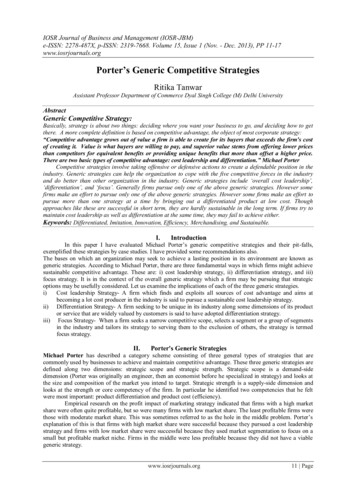
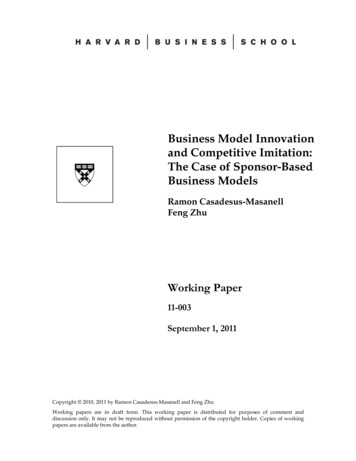
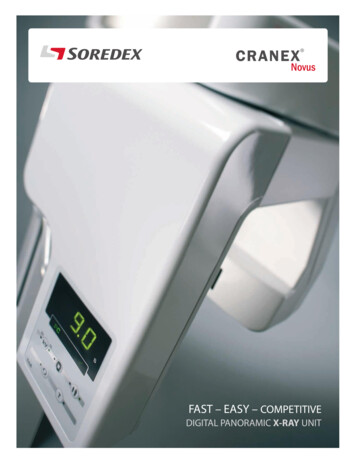

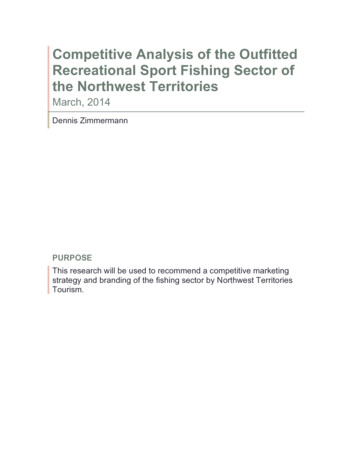
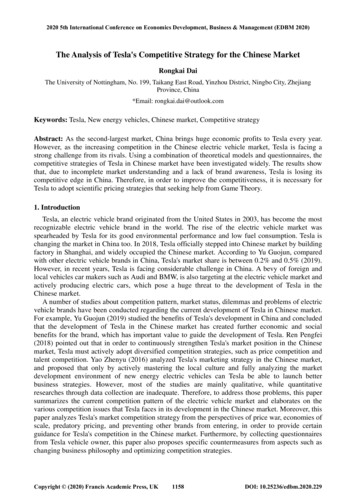
![05[2] Strategy competitors, competitive rivalry .](/img/2/052-strategy-competitors-competitive-rivalry-competitive-behavior-and-competitive-dynamics.jpg)


